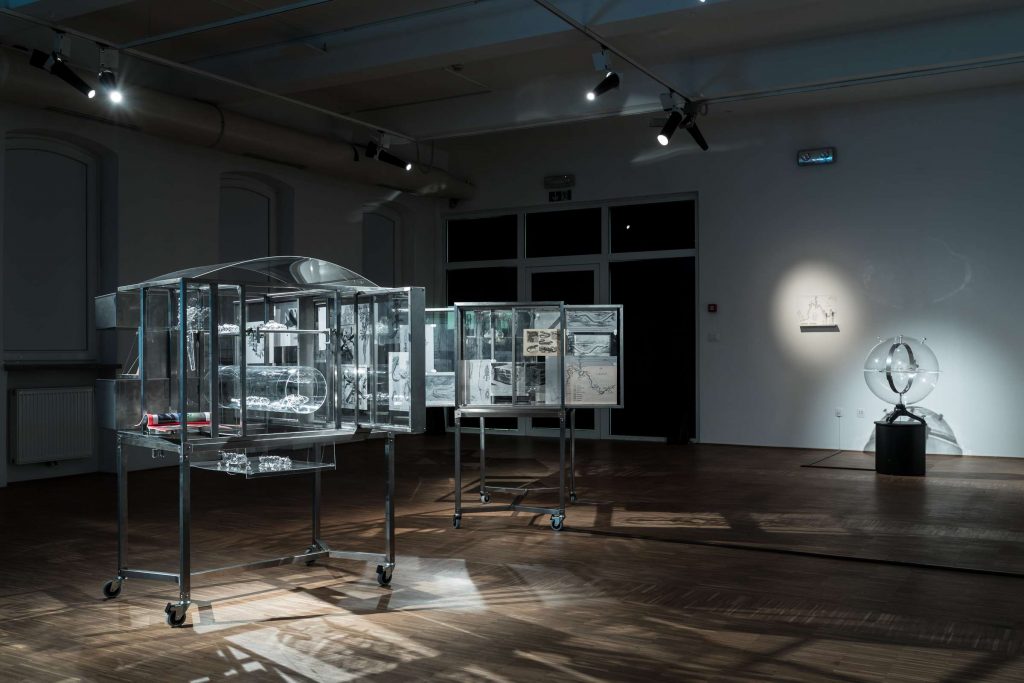[slovenski tekst ⇊⇊]
Lygophilia is a series of research-based artworks initiated in 2017 by Robertina Šebjanič in Mexico and pursued in Slovenia to explore the love (Gr.: philéō) of darkness (Gr.: lúgē) and the unknown dwellers in places inhospitable for humans.
The opus of works Lygophilia:
Neotenous dark dwellers_Lygophilia, installation, 2018
Piscis ludicrous / Transfixed Gaze_Lygophilia, video essay, 2017
Dark Drops_ Lygophilia, sound composition, 2017
Odorantur_Lygophilia, installation, 2019
and
online publication – video capsule Neotenous Dark Dwellers – Lygophilia, Robertina Sebjanic edited by Annick Bureaud on MemoRekall. http://archive.olats.org/ope/ope.php
(best to use in Firefox and Safari in Chrome is not working)
Neotenous dark dwellers – Lygophilia / installation / by Robertina Šebjanič, production Projekt Atol Institute, 2018
Lygophilia weaves together mythologies and sciences, history and future, fears and desires, continents, cultures, humans and non-humans. Lygophilia folds and unfolds the stories carried by those fascinating creatures that are the Mexican Axolotl and the Slovene Proteus.
From immortality to regenerative medicine — both animals are, as adults, in a state of “eternal youth” (neoteny) showing extraordinary longevity and regenerative abilities that put them at the centre of ancient myths as well as current cutting-edge scientific researches.
Credits:
Artist: Robertina Šebjanič // Curating and advising: Annick Bureaud // Scientific advisory: Tular Cave Laboratory // Glassblowing: Pero Kolobarić and Jireh Glass // Metal construction: Roman B.
Production: Projekt Atol (Uroš Veber), Slovenia, 2018 & Arte+Ciencia (UNAM), Mexico 2017; Sektor Institute, Slovenia 2017 / 2018
Production support: Ministry of Culture of Slovenia and the Municipality of Ljubljana
Special thanks to: Aisen Caro Chacin, Miha Godec, Rampa Lab, Osmo/za Consortium, Bunker team
photos by Miha Godec
More: http://robertina.net/neotenous-dark-dwellers-lygophilia/
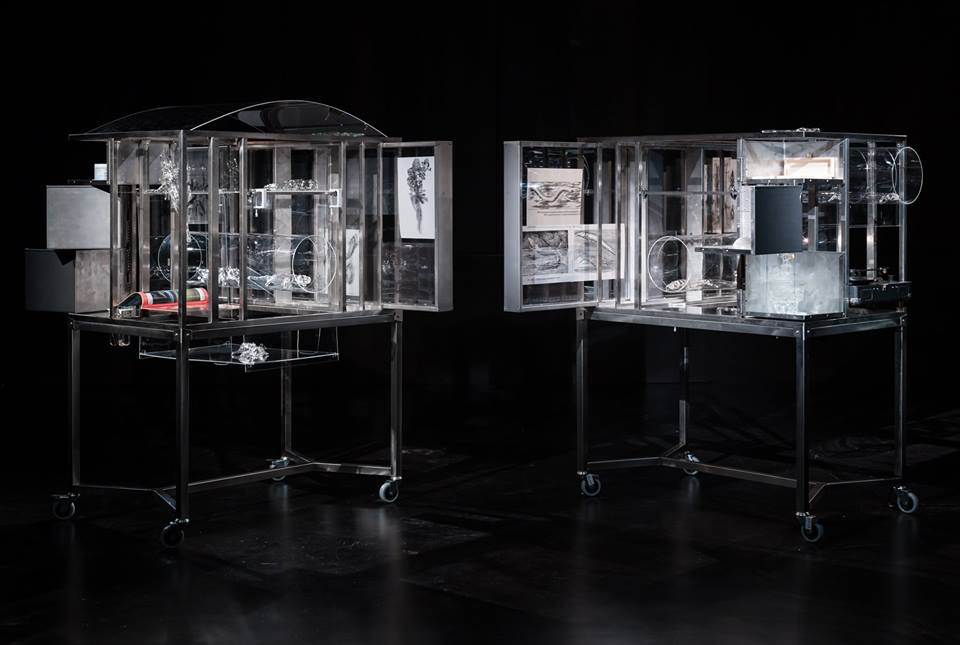
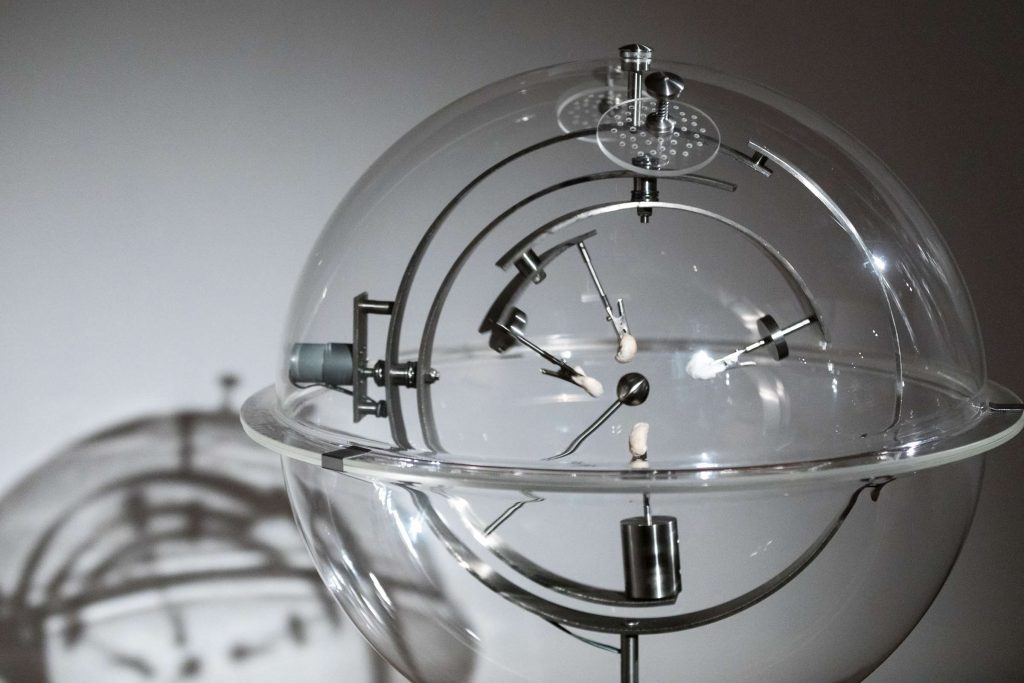
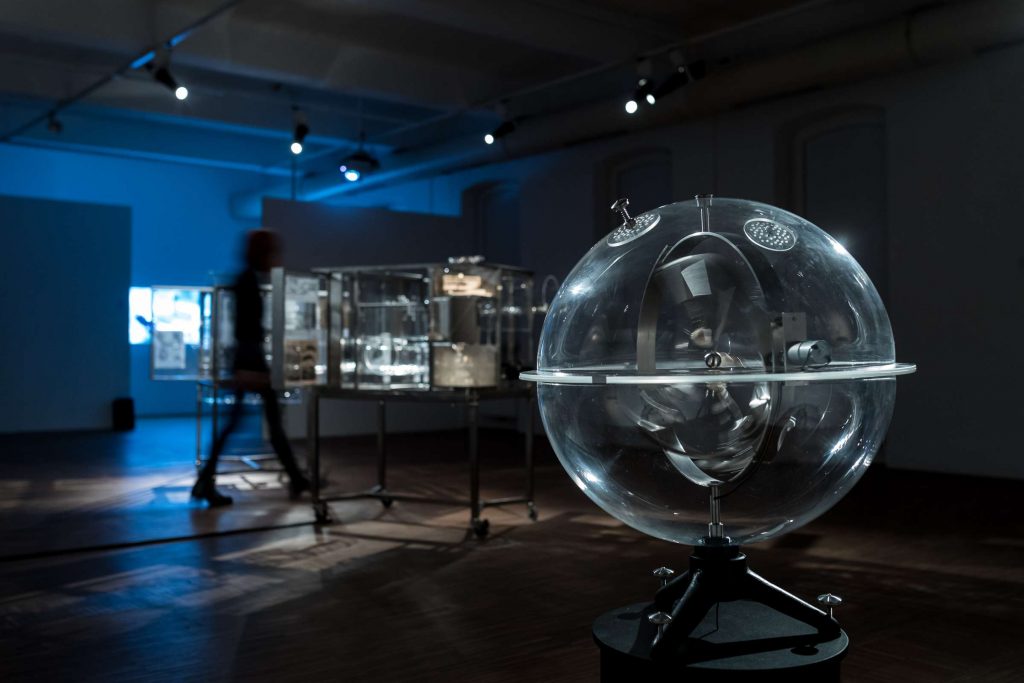
Odorantur_Lygophilia, installation, 2019
Odorantur_Lygophilia (installation) – in which the artist takes the viewer into the Proteus’ environment
by triggering various sensory perceptions. Life and evolution in the darkness raises the question as to
how proteus can perceive space and how it orientates in it. As an animal species whose eyes have
become degenerate for no use of sight, it heightened other senses, including smell. Water pollution
therefore causes not only the accumulation of toxic substances in its body, but it also robs it from
another way of perceiving the environment, hinders its communication with other species, and
prevents it from detecting its prey.
Odorantur _Lygophilia
installation
Artist, research, development: Robertina Šebjanič
Technical support and development: ScenArt d.o.o.
Development of the smell / odour: Marko Žavbi
Production: Projekt Atol (Uroš Veber) and Museum and Galleries of Ljubljana
Year of production: 2019
Special thanks: Tular Cave Laboratory, BioTehna
Production support: Ministry of Culture of Slovenia and the Municipality of Ljubljana
Piscis ludicrous / Transfixed gaze (Lygophilia), video essay, 15′ 30”, 2018
Piscis ludicrous / Transfixed Gaze intervenes into environments and discusses ecology in order to establish substantial changes in an ecosystem. It explores how to perceive the parameters of the ecological needs of other species in the times of dark ecology. It questions the relationship between mythology and scientific facts merged with popular culture, and invites us to gain a more profound view of interspecies cohabitation and coexistence with a focus on relationship between axolotls and humans.
The axolotl is a neotenic salamander native to North America found in the highland lakes of Mexico. The narratives of the axolotl’s complex history, present and future are viewed through different lenses:
- Axolotl as a species that is facing extinction in its natural environment;
- Axolotl as a subject of scientific research considering its extraordinary regenerative abilities and the promise of everlasting life;
Axolotl as a cultural heritage representing biopolitical and decolonial relations, displaying the connection between mythology in the contemporary world.
More: http://robertina.net/piscis-ludicrous-tranfix-gaze-lygophilia/
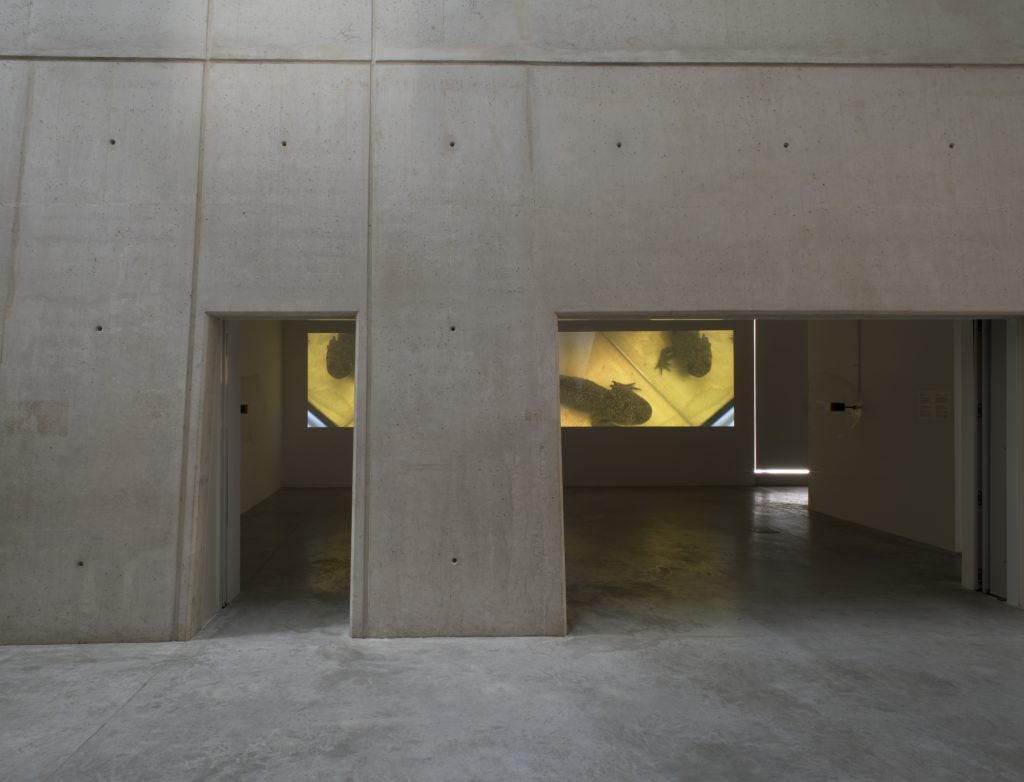
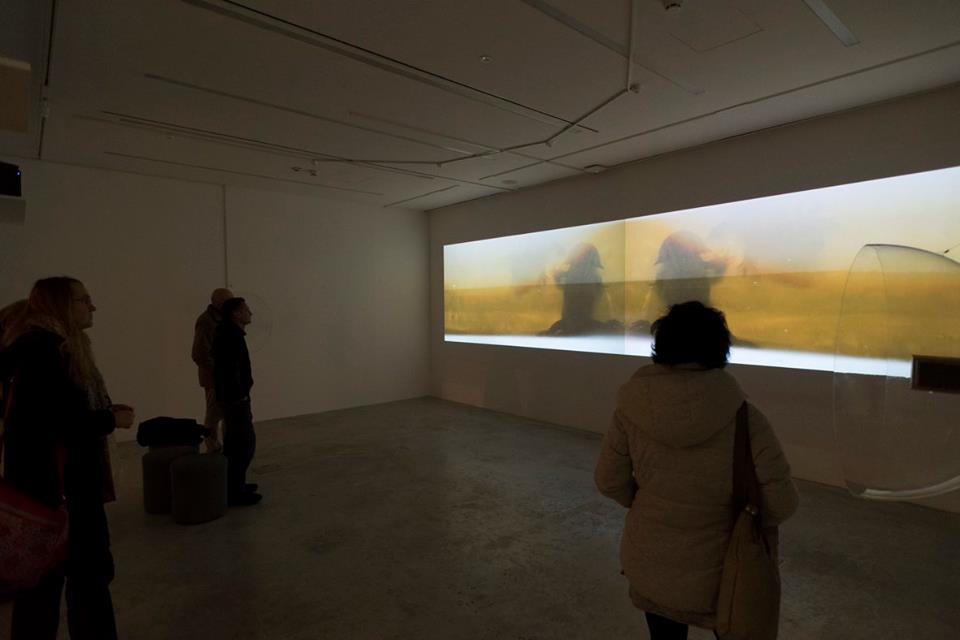
Dark drops, sound composition 2017, vinyl 2018/2019 (SubAqua – Sektor Institute)
Drops that resonate in the darkness of the caves, are condensed representation of a complex and extreme environment that is still full of mystery, darkness and a special beauty, where the geological and biological time are seems to happen in different time span.
In the caves the sound of the water dropping has a strong presence, as is the sound that is breaking the silence to the proteus / olm*. This little drops are the “information transfer”, getting the info about the living conditions from above that are coming deep into the cave and they are the source of food for biological life as the building material for the geological structures.
*The proteus or olm also known as the proteus or the cave salamander – Proteus anguinus) is a blind amphibian exclusively found in the underwater caveskast area in Slovenia and also in some parts of of southern European (Italy, southwestern Croatia, and Bosnia and Herzegovina)
Sound composition:
https://robertina.bandcamp.com/track/dark-drops-lygophilia
More: http://robertina.net/dark-drops/
To be a thing at all – a rock, a lizard, a human – is to be in a twist.
How thought longs to twist and turn like the serpent poetry!
Timothy Morton (Dark Ecology)
Lygophilia / Transfixed gaze (August – September 2017)
Mexico city, art – research residency at Arte+Ciencia at UNAM and development for a festival Transitio_MX:
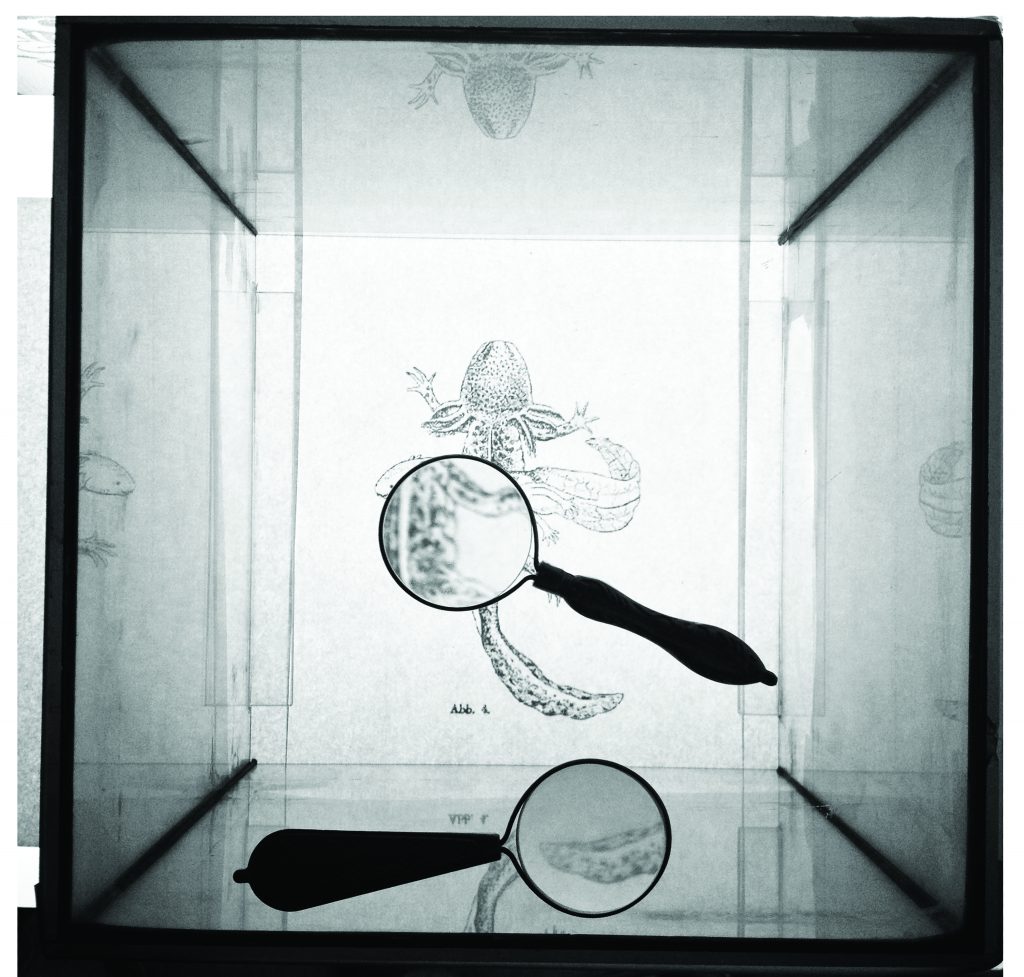
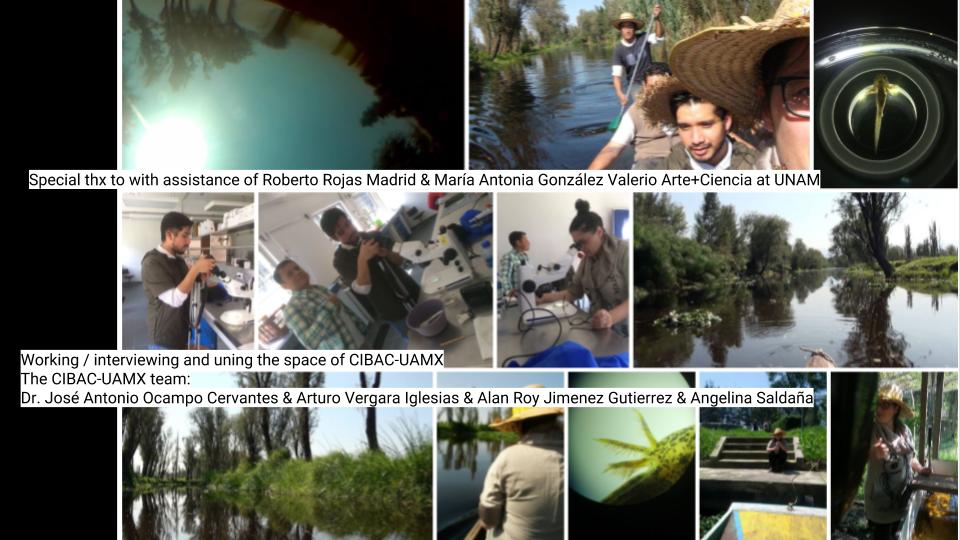
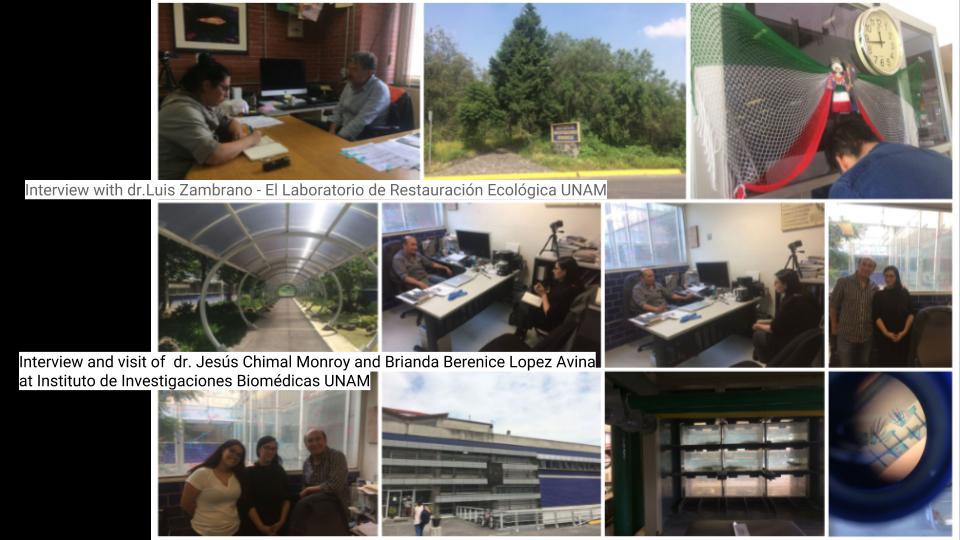
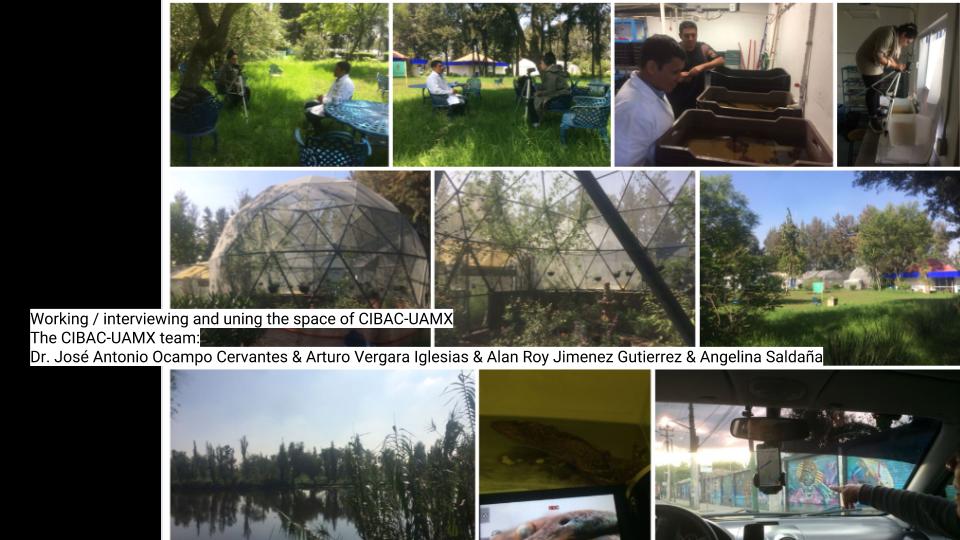
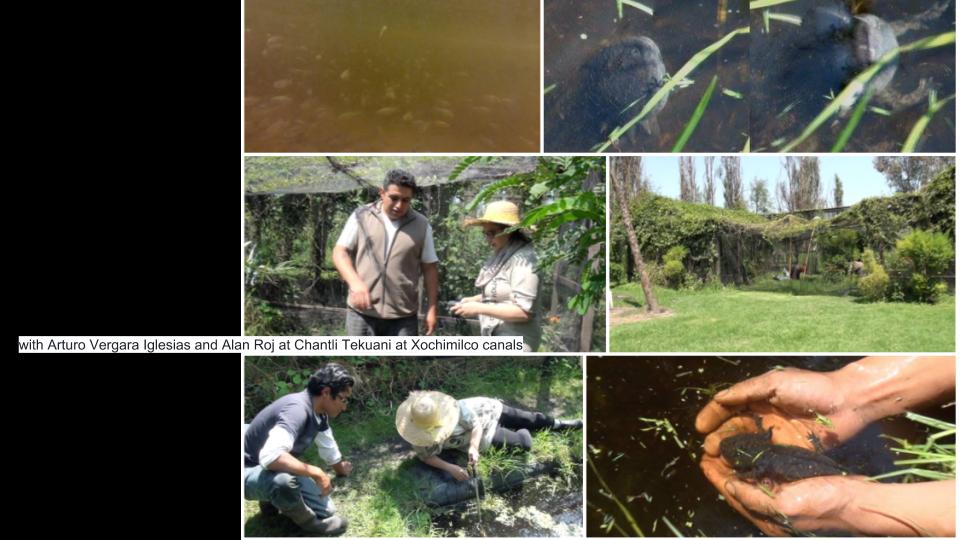
(scroll down for Spanish text – español abajo )
The project Lygophilia / Transfixed gaze showcases the Axolotl through different narratives:
– as a species that is facing extinction in natural environment;
– as a subject of scientific research considering its fascinating regenerative abilities;
– as a cultural imperative that helps to understand bridge between the past and future.
The Lygophilia / Transfixed gaze encourages viewers to reflect on new (ecological) realities in the time of the Anthropocene. It intervenes into environments and discusses ecology in order to establish the extent of substantial changes in ecosystem. It explores if and how we are able to perceive the parameters of ecological needs of other species in the times of dark ecology.
The mythology and scientific facts, merged with popular culture, invite audience to gain a more profound view of (inter)species’ cohabitation. Since the end of the 19 th century the number of Axolotls has increased, however, in laboratories, where they are examined for their biological advantages of their perpetual youth. On the other hand humans are the cause for (imminent) extinction of Axolotls in their natural habitat. The lakes surrounding Mexico City, where Axolotls originally live(d) in the darkness of the swamps, are losing the symbol which connects the future with the past.
The project thus opens the questions: Who observes whom? Who is seen as a monster and who is perceived as an optical illusion?
________________________________________________________________________________________________________________________________________
Credits (not final credits yet as project is still in research / development phase)
Author: Robertina Šebjanič
Assistant: Roberto Rojas Madrid
Curator of Transitio_MX: Pedro Soler
Production support:
Projekt Atol, Ministry of culture of Republic of Slovenia,Transitio_MX, Sektor, Centro de Investigaciones Biológicas y Acuícolas de Cuemanco Universidad Autonoma Metropolitana Unidad Xochimilco (CIBAC-UAMX), Arte+Ciencia at UNAM
art/research residency at Arte+Ciencia at UNAM lead by María Antonia González Valerio with assistance of Roberto Rojas Madrid.
Consultancy / Special thanks:
Tzintia Mendoza, Dr. José Antonio Ocampo Cervantes & Arturo Vergara Iglesias & Alan Roy Jimenez Gutierrez & Angelina Saldaña from CIBAC-UAMX (Centro de Investigaciones Biológicas y Acuícolas de Cuemanco Universidad Autonoma Metropolitana Unidad Xochimilco), dr. Jesús Chimal Monroy and Brianda Berenice Lopez Avina at Instituto de Investigaciones Biomédicas UNAM, Arte+Ciencia UNAM University, María Antonia González Valerio, Roberto Rojas Madrid, dr.Luis Zambrano from El Laboratorio de Restauración Ecológica UNAM, Francisco Martinez Perez, Secretario Auxiliar de la Cantera Oriente (REPSA),Miha Colner (Sektor), Sarah Hermanutz, Annick Bureaud, Ale de la Puente, Ida Hiršenfelder, Kristijan Tkalec (Rampa Lab), Gregor Aljančič (Tular Cave Laboratory), El Laboratorio de Restauración Ecológica UNAM,Transitio_MX festival at Centro Multimedia celebrado en Centro Nacional de las Artes (CENART)……
+ more organizations and individuals involved in the conservation of Axolotl at its natural environment (full credits of all the collaborators will be updated – as the project is still in development and it will premiered at the Transitio_MX festival, Mexico City)
UPDATE: 2017, 21 September: In light of all the tragic events that happened in last days in Mexico and as gesture of the solidarity are all public events canceled. Due to the earthquake and the declaration of emergency in Mexico, the Transitio_MX festival is canceled. – premiere 26. September, 8 pm, at Transitio_MX festival at Centro Multimedia celebrado en Centro Nacional de las Artes (CENART) in Mexico City, curated by Pedro Soler,
art/research residency at Arte+Ciencia at UNAM, lead by María Antonia González Valerio with assistance of Roberto Rojas Madrid
________________________________________________________________________________________________________________________________________
Lygophilia / Transfixed gaze
Audio y acto visual en vivo con un organismo vivo.
La pieza lygophilia / transfixed gaze invita a los espectadores a reflexionar sobre nuevas realidades (ecológicas) en la era del Antropoceno. Interviniendo los ambientes se analiza la ecología para establecer el alcance de cambios sustantivos en el ecosistema. Explora si es posible y como, percibir los parámetros de las necesidades ecológicas de otras especies en tiempos de ecología obscuras.
La mitología y los hechos científicos, fusionados con la cultura popular moderna, invitan a la audiencia a obtener una visión más profunda sobre la coexistencia entre especies. La extinción del ajolote en su hábitat natural y de los lagos que rodean la Ciudad de México, son un claro ejemplo de una comunidad que está perdiendo sus símbolos y, junto con ellos, su vínculo con el pasado. Desde finales del siglo XIX, el número de ajolotes ha aumentado, pero únicamente en laboratorios, donde se les estudia por su capacidad para regenerar tejidos y mantener su rejuvenecimiento. El proyecto por lo tanto plantea las siguientes preguntas: ¿Quién observa a quién? ¿A quién se le percibe como un monstruo y a quién se le percibe como una ilusión óptica?
Colaboradores del Proyecto:
Autora y directora del proyecto: Robertina Šebjanič
Asesoría y consultoría: Roberto Rojas Madrid
Curador de Transitio_MX: Pedro Soler
Colaboradores de apoyo a la producción: Ministerio de Cultura de la República de Eslovenia, Projekt Atol, Transitio_Mx, Arte+Ciencia de la UNAM, Sektor, Centro de Investigaciones Biológicas y Acuícolas de Cuemanco Universidad Autonoma Metropolitana Unidad Xochimilco (CIBAC-UAMX)
Residencia de investigación de Arte+Ciencia at UNAM, coordinado por María Antonia González Valerio con la asistencia de Roberto Rojas Madrid
Nuevo proyecto en desarrollo – estreno en Transitio_MX Festival del Centro Multimedia celebrado en Centro Nacional de las Artes (CENART) en la Ciudad de México, curado por Pedro Soler
Agradecimientos especiales:
Tzintia Mendoza, Dr. José Antonio Ocampo Cervantes & Arturo Vergara Iglesias & Alan Roy Jimenez Gutierrez & Angelina Saldaña from CIBAC-UAMX (Centro de Investigaciones Biológicas y Acuícolas de Cuemanco Universidad Autonoma Metropolitana Unidad Xochimilco), dr. Jesús Chimal Monroy and Brianda Berenice Lopez Avina at Instituto de Investigaciones Biomédicas UNAM, Arte+Ciencia UNAM University, María Antonia González Valerio, Roberto Rojas Madrid, dr.Luis Zambrano from El Laboratorio de Restauración Ecológica UNAM, Francisco Martinez Perez, Secretario Auxiliar de la Cantera Oriente (REPSA),Miha Colner (Sektor), Sarah Hermanutz, Annick Bureaud, Ale de la Puente, Ida Hiršenfelder, Kristijan Tkalec (Rampa Lab), Gregor Aljančič (Tular Cave Laboratory), El Laboratorio de Restauración Ecológica UNAM,Transitio_MX festival at Centro Multimedia celebrado en Centro Nacional de las Artes (CENART)……
________________________________________________________________________________________________________________________________________
To be a thing at all – a rock, a lizard, a human – is to be in a twist.
How thought longs to twist and turn like the serpent poetry!
Timothy Morton (Dark Ecology)
The project Lygophilia / Transfixed gaze showcases the Axolotl through different narratives:
– as a species that is facing extinction in natural environment;
– as a subject of scientific research considering its fascinating regenerative abilities;
– as a cultural imperative that helps to understand bridge between the past and future.
The project Lygophilia / Transfixed gaze encourages viewers to rethink the concept of new (ecological) realities in the time of Anthropocene. It intervenes into environments and discusses ecology in order to shed light to the extent of substantial changes in the ecosystem and how these affect the existence of a single species and their effect on the entire habitat?
The mythology and scientific facts, merged with popular culture, invite viewers to understand the life of (inter)species’ cohabitation more profoundly. In the short story entitled ‘Axolotl’ by Julio Cortázar’s, the narrator is transfixed. He experiences his own metamorphosis transforming into Axolotl: “I stayed watching them for an hour and left, unable to think of anything else”.
The atmospheric, audio-visual performance (installation) by Ljubljana-based artist Robertina Šebjanič thus offers distorted view of the Axolotls, while the viewer is still restricted to experience the transfer that Cortázar writes about. However, the project tends to challenge the perception of Axolotls and to restore the relationship of humankind with its natural environment. It explores if and how we are able to perceive the parameters of ecological needs of other species the times of dark ecology.
The extinction of Axolotls in their natural habitat, caused by human intervention, is ongoing; it takes place on a daily basis. The lakes surrounding Mexico City, where Axolotls originally live(d) in darkness of the swamps, are losing the symbol which connects past and future.
The complete extinction of Axolotls in the wilderness could also wipe out important indications which are very useful for environmentalists and scientists studying their perplex traits. Since the end of the 19th century numbers of Axolotls has increased, however, only in laboratories. There they have been bred and raised successfully as laboratory specimens having been a subject of investigation due to their extraordinary biological ability to regrow severed limbs, gills or tails as well as to make head transplants. Experiments using Axolotls as specimens help scientists understand principles of regeneration and aging. The quest to unlock their secrets which hide in very principles of their complex organisms have captivated human minds for centuries.
Axolotls have very rare amphibian capacity to grow into adulthood without undergoing metamorphosis and therefore live in an everlasting adolescent stage. They are the model species resonating with desires of humans who long for perpetual youth. Therefore it is almost impossible for humankind to see Axolotls as they are – animals in the process of inevitable extinction. Instead of being common residents in the laboratories where they are investigated for their mysterious biological advantages, Axolotls are characterized for their strong cultural references – as mysterious creatures that never age.
Therefore the artist questions different aspects of their existence. Who observes whom? Who is perceived as a monster and who is perceived as an optical illusion? It is highly important to explore ecosystems as well as to understand (bio)political systems that reflect on current society.
Progress means: humanity emerges from its spellbound state no longer under the spell of progress as well, itself nature, by becoming aware of its own indigenousness to nature and by halting the mastery over nature through which nature continues its mastery. Theodor Adorno
________________________________________________________________________________________________________________________________________
________________________________________________________________________________________________________________________________________
V središču projekta Ligofilia – Premeščeni pogled, ki bo predstavljen v obliki video eseja in terenskih zvočnih posnetkov, je dvoživka aksolotl imenovana tudi mehiški salamander, ki jo delo obravnava skozi različne perspektive: kot skrajno ogroženo vrsto; kot predmet znanstvenih raziskav, predvsem zaradi svojih regenerativnih sposobnosti; kot kulturni pojav, ki nam pomaga razumeti most med preteklostjo in prihodnostjo. Projekt naslavlja gledalce v okontekstu nove ekološke realnosti antropocena. Loteva se prepleta bogate lokalne mitologije, pomešane s pop kulturo ter sočasnega obširnega in dolgotrajnega znanstvenega raziskovanja aksolotla. Kljub izumiranju aksolotla v naravnem okolju, zaradi onesnaženja in vdora človeka v močvirnata območja, se je od konca 19. stoletja število aksolotlov povečalo, zaradi njihove rabe v laboratorijskih raziskavah, v katerih se je znašel zaradi svoje večne mladosti, sposobnosti proizvajanja primarnih celic v odrasli dobi. Z jezeri bogata okolica Mexico City, kjer so v temačnih mlakah Xochimilko jezera bivali aksolotli, počasi izgubljajo vrednost kot kultrurni simbol povezovanja prihodnost s preteklostjo.
Raziskavo za projekt Ligofilija je umetnica opravila na rezidenci v Mehiki v sodelovanju z Centro de Investigaciones Biológicas y Acuicolas de Cuemanco (CIBAC) in programom Arte+Ciencia pri UNAM (Universidad Nacional Autónoma de México).
